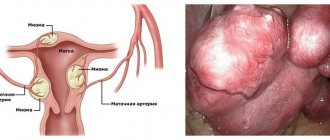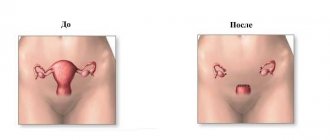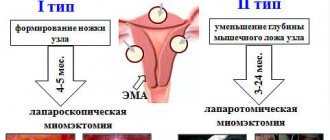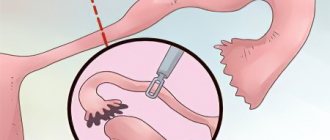How long does pain last after removal of uterine fibroids? The reason for pain after removal of uterine fibroids is the formation of a postoperative scar . How severe the pain will be depends on how the operation was performed - abdominal or laparoscopy.
After surgery, the body's reaction to this procedure can be unpredictable, which can change the patient's usual life. It is for this reason that you should learn in advance about the stages of the postoperative period and the possibility of preserving reproductive function. In recent years, such a benign neoplasm in the uterine cavity has been increasingly diagnosed, the treatment of which can be carried out in various ways, and removal is considered one of the most effective.
Development and reasons
The disease can manifest itself quite early, at about 27-30 years of age. At this age, hormonal disorders associated with a malfunction of the endocrine system, gynecological diseases of various origins and other pathologies are already possible. Under the influence of these factors, cell mutation occurs in the pelvic organs, which subsequently affects processes in the myometrium.
External factors also influence the formation of myomatous nodes. Lack of childbirth and lactation, surgical abortions, taking hormonal drugs, as well as ultraviolet radiation.
Before the age of 35, fibroids are rarely large and their development is moderate. Usually the patient is simply observed by a doctor; no treatment is required. At later ages, ovarian function declines, the woman’s body is in the premenopausal period, which provokes tumor growth. Too abrupt entry into menopause or, conversely, a protracted process (the onset of menopause after 50 years) also affects the growth of fibroids.
Diseases such as metabolic disorders, obesity and endometriosis at this age can lead to active proliferation in the body, which may lead to an oncological process.
Reviews
It is almost impossible to diagnose fibroids on your own, therefore, in order to identify the problem in a timely manner, you should be seen by a gynecologist regularly, at least 2 times a year. Under no circumstances should you rely on traditional medicine - time will be wasted, and the consequences for the body will be extremely sad.
You can express your opinion or share your own story below this article in the “comments” section.
If you find an error, please select a piece of text and press Ctrl+Enter.
Classification
Myoma is a node, the size of which can start from a few millimeters and grow to several centimeters. The composition of the node depends on the parent cell and can be:
- epithelioid;
- vascular;
- adenomatous;
- intravenous.
Fibroids can be classified into several types:
- by the nature of localization: muscular, subperitoneal, submucosal, intermediate fibroids;
- by size of formation: small (up to 3 cm), medium (up to 6 cm), large (from 8 cm);
- by location in the organ: in the cervix, isthmus, in the body and on the fundus of the uterus;
- by the nature of growth: true and false.
Price
It is difficult to say the exact amount that will have to be spent on the operation. This depends on the region where the woman lives, the status of the clinic and the level of qualifications of the surgeon, materials and medications used in the process of abdominal surgery.
In addition, the clinical picture and stage of the disease, as well as the size of the fibroids, play an important role. On average, strip cutting of a tumor in a paid clinic will cost from 9-10 thousand rubles to 70 thousand.
In municipal medical institutions at the place of registration of the patient, such an operation is performed free of charge.
Symptoms and diagnosis
The disease does not have pronounced symptoms. Therefore, it can be latent for a long time. However, a woman may be bothered by permanent pain in the lower abdomen during menstruation, and the nature of the discharge itself becomes more abundant and can lead to a mild form of anemia. Rarely leads to infertility.
All these symptoms are precursors to many other gynecological diseases. If present, a medical examination is recommended to determine the true cause. In addition, many women experience painful and heavy menstruation in the absence of pathology.
With extensive damage, symptoms will be more obvious. Constant pain may be associated with the intensive growth of myomatous nodes. If the process of tumor necrosis has begun, pain will be accompanied by an increase in body temperature. If the myomatous node has a leg, then there is a risk of torsion of the node, disrupting its nutrition. The pain syndrome will be pronounced and there is a high risk of peritonitis. What will be the basis for urgent surgery.
Heavy menstruation may indicate the presence of submucosal fibroids (submucosal location of nodes), and if such a tumor becomes large, intermenstrual bleeding may occur, which leads to anemia.
Subperitoneal fibroids manifest as severe pain in the lower back and lower abdomen due to uterine tension. The node itself can compress the nerve plexuses of the pelvic organs.
Fibroids can lead to infertility by squeezing the fallopian tubes due to their large size, thereby impairing their patency. Or negatively affect endometrial blood flow.
Diagnosis of fibroids is simple and is carried out using ultrasound (ultrasound). If nodular formations with low density in relation to the myometrium are detected, the node is described as myomatous. Tomographic examination is rarely prescribed and in cases where there is a suspicion of a tumor process.
Diagnostics
Methods for diagnosing myomatosis:
- Gynecological examination of the woman’s genital organs, which is confirmed by the methods described below. When detecting pathology, the size of the tumor and the experience of the doctor are important.
- Transabdominal ultrasound examination of the uterine cavity, which examines the condition of the pelvic organs, and transvaginal ultrasound - penetration of the sensor into the vaginal cavity. It is carried out to obtain accurate results even in the early stages.
- Magnetic resonance imaging and computed tomography are modern technologies that can perform a detailed, layer-by-layer examination of the tumor.
- Hysteroscopy – obtaining results by instrumentally taking material to examine the mucous membrane of an organ. Used for diagnostic and therapeutic purposes. The location of polyps, submucous nodes, and septa in the uterine cavity is determined and removed immediately.
- X-ray is used to study the characteristics of the blood vessels of the pelvic organs, does not ignore the inner uterine layer of connective tissue, and identifies developing tumors.
Treatment
Small lesions at the age of 30-35 years, according to many experts, do not require treatment. Hormonal therapy may be prescribed, but since the composition of the myomatous node is heterogeneous (heterogeneous), such treatment may not bring the expected results. A much more effective treatment method is surgery.
This method is necessary primarily when the tumor is actively growing and is large in size. Surgical intervention is also justified in the absence of tumor regression after menopause, a certain location (for example, the cervix), a malignant process, etc.
Important! If a myomatous node, even a small one, is detected, annual ultrasound monitoring and consultation with a gynecologist is necessary. In order to promptly notice the progress of the tumor and, by selecting the optimal treatment, avoid total resection of the pelvic organs.
Preparatory stage
Preparation for fibroid removal includes studies that a woman undergoes before the intervention:
- gynecological examination (two-handed and using mirrors);
- taking anamnesis;
- vaginal smears for genital infections and microflora;
- ultrasound examination of the uterus, cervix and ovaries;
- general and clinical blood test;
- general urine analysis;
- electrocardiogram;
- coagulogram.
Additionally, the doctor may prescribe hysteroscopy and magnetic resonance imaging of the pelvic organs. In some cases, consultation with narrow specialists is required, which the patient undergoes to obtain an opinion.
Abdominal surgery as the main method of treatment
Abdominal surgery to remove uterine fibroids is the most common way to solve the problem.
There are 2 types of tumor removal operations: myomectomy and hysterectomy.
Myomectomy
The goal of conservative (conserving) myomectomy is the excision of myomatous nodes while preserving the uterus.
This option of abdominal surgery is well suited for young women under the age of 40 who do not have children or who want to become pregnant in the future. For small fibroids, as well as in the presence of pedunculated nodes and their slow development, myomeotomy is also suitable.
In a laparotomy (open) myomectomy, the doctor makes a transverse incision in the lower abdomen. Conducts a thorough examination of the uterus, palpating it (if necessary, opening it).
Myomatous nodes on the stalk are cut off, leaving the capsule itself intact, away from the uterine wall. The fact is that the leg is part of the wall of the uterus, as it consists of the same tissues. If the excision is incorrect, it will be difficult to suture, healing will be slow, with possible complications.
Do not watch for the faint of heart (Pictures from myomectomy operations)
In the presence of ordinary myomatous nodes, an incision is made, dissecting the capsule of the tumor formation, touching the wall of the uterus. Using instruments, the tumor is removed from the capsule, the bleeding is stopped, and then stitches are applied. After this, the cavity is toileted.
The remaining tumors are excised in the same way.
Complications
Complications after myomectomy are the same as any other gynecological operation. Inflammatory processes are possible, which can be easily stopped with antibiotics. The adhesions process and the presence of scars on the uterus can negatively affect attempts to conceive a child.
It should be understood that if the morphological nature of the tumor has high proliferative activity, even when it is removed, growth rudiments may remain. Therefore, the negative consequence of partial tumor removal (myomectomy is aimed at preserving the uterus) is the high probability of relapse. According to statistics, it occurs in 40% of women.
Modern surgical methods for treating fibroids do not stand still, and in addition to laparotomy myomectomy, it is possible to perform the operation in other ways.
- hysteroscopy
This is only possible if the node is located in the uterine cavity. A hysteroscope is inserted into the vagina, and with its help the doctor performs the necessary manipulations to remove the formation.
- laparoscopy
Three small incisions are made on the patient's body to insert instruments. With their help, excision of myomatous nodes occurs.
There are a number of contraindications to myomectomy. Temporary ones include the presence of anemia and inflammatory processes in the pelvis. Absolute contraindications are disruption of blood flow in the tissues of the node, resulting in tumor necrosis and oncology.
Hysterectomy
Open hysterectomy is a gynecological operation aimed at complete removal of the uterine body with possible resection of the ovaries and fallopian tubes.
The operation is indicated for recurrence of fibroids after myomectomy, with a large area of damage and in the presence of an oncological process.
There are several types of hysterectomy, and the choice is made according to medical indications.
- partial (subtotal)
The most common type of surgery for fibroids. Only the body of the uterus is removed; other pelvic organs are not affected.
- total
The body of the uterus is removed along with the cervix, but the ovaries, tubes and appendages are not subject to resection.
- radical
In addition to removing the body of the uterus, its cervix and tubes, part of the vagina and lymph nodes are excised.
With an open hysterectomy, a transverse incision is made in the lower abdomen, then the affected organs are excised (depending on the type of operation), the bleeding is stopped and stitches are applied. After this, the cavity is toileted.
The operation is very traumatic and requires a long rehabilitation period.
It is possible to reduce the consequences of such an operation by performing it using the Da Vinci robotic installation. Despite the fact that an operation using such a device will be considered a cavity operation, the incisions and blood loss will be minimal, therefore, the recovery period will be much faster. Reviews from women who have undergone hysterectomy with this device and are undergoing rehabilitation are positive. (In the picture on the right)
The robot surgeon is truly unique. The doctor, controlling a separate console, performs the necessary manipulations using the “hands” of the robot while monitoring his actions using a monitor.
But this method is not available to everyone. At the moment, there are only 25 Da Vinci installations throughout Russia (a video of an operation performed using a robotic surgeon can be viewed at the end of the article).
In some cases, hysterectomy is also possible through laparoscopy and hysteroscopy.
After the operation, the woman completely loses her reproductive function. Hysterectomy does not affect your sex life in any way; you just need to wait out the rehabilitation period. If part of the vagina was excised during surgery, discomfort may occur during sexual intercourse. If the ovaries have been removed and menopause has not yet occurred, decreased libido, depression, and osteoporosis may occur.
Restorative procedures
To relieve pain during the recovery period, strong painkillers are prescribed. Additionally, antibiotics and anticoagulants.
To replenish blood volume, intravenous infusion of drugs is performed. The patient is prescribed a diet high in protein, if possible and there are no concomitant pathologies (kidneys, gall bladder).
After 5-7 days, a woman should get up and go for a walk, then constant physical activity is indicated.
After the superficial sutures are removed (up to 14 days), the woman is discharged under the supervision of a doctor in the antenatal clinic.
Rehabilitation after removal of uterine fibroids includes a set of measures:
- drug treatment - upon discharge, hormonal drugs are prescribed for a smoother adaptation of the body to the new status and prevention of early menopause, restoratives, sedatives;
- a diet that should allow you to empty your bowels every day without pain or strain;
- correct daily routine - moderate physical activity is indicated, saunas and steam baths should not be visited, the daily regimen should include mandatory full sleep.
Pregnancy after removal of uterine fibroids is permitted one year after the operation.
Once every six months, a woman should see a doctor for a follow-up examination.
Advantages of abdominal operations
Despite the high traumatic nature of such operations and the long rehabilitation period, there are also advantages. And in some cases, this is the only possible path to recovery.
The absolute indications for open myomectomy or hysterectomy are extensive proliferation of myomatous nodes, their large size and, of course, a malignant process. Under such conditions, laparoscopic and hysteroscopic operations are not possible.
When using a laparoscope, the risk of bleeding increases, which is difficult to stop; during laparotomy (open surgery), thanks to free access, such consequences can be avoided. If the doctor lacks the skills to operate the laparoscope, then there is a possibility of damage to nearby healthy organs, as well as incomplete excision of the tumor.
Providing assistance with this disease
Resolution of the disease is achieved by several methods of therapy: conservativeness, symptomatic treatment, pain relief and surgery.
The choice of therapeutic actions depends on the stage of tumor development, progression and symptoms.
Conservative therapy and pain relief
Conservativeness lies in the fact that the patient receives hormonal drugs and medications aimed at relieving associated pain to provide symptomatic assistance.
Before prescribing painkillers to the patient, an ultrasound examination and collection of tests are performed, since the selection of analgesics requires care and caution on the part of the attending physician. To relieve pain and not cause harm, adhere to strict prescriptions for taking medications:
- Over-the-counter - a woman relieves pain at home on her own, following a doctor’s prescription to avoid unwanted side effects, such as gastritis, stomach ulcers. Drugs include non-steroidal anti-inflammatory drugs (Paracetamol, Ibuprofen, Meloxicam).
- Sedatives will help relieve nervous tension and alleviate a person’s stressful state, which leads to imbalance, exhaustion of the body, and deterioration of not only psychological health, but also the course of the disease.
- Heat applied to the lower abdominal area relieves cramps, relaxes muscle tone and improves blood flow. Severe pain symptoms are alleviated with this method.
Surgical intervention
The way to eliminate the disease is surgery. Surgical resolution prevents further development of the tumor through surgical removal. But this method is used only if the formation progresses in growth. The doctor also takes into account the woman’s age, the number of growths and location.
Thus, therapy is much more productive at the initial stage of development. Early detection of fibroids helps to avoid surgery and be conservative.
Rehabilitation after abdominal surgery
Postoperative rehabilitation can last up to six months. After discharge from the hospital, a woman needs to follow simple recommendations. During the month, active physical activity and sports are prohibited, you cannot lift weights, and abstain from sexual contact. Contraindications include visiting a sauna, swimming pool and various hypothermia.
You should carefully monitor your diet. Food should contain a large amount of fiber, which has a beneficial effect on intestinal function.
Physiotherapy and massage may be prescribed.
If reproductive function is preserved, planning for a subsequent pregnancy should be postponed for at least a year.
At certain intervals in the postoperative period, visit a gynecologist and conduct a control ultrasound examination.
Nutritional Features
Strict adherence to the diet during the period of recovery of the body is the key to the appearance of quick positive results from the treatment. What can you eat?
Firstly, these are foods that are easily digestible: boiled or steamed vegetables, fresh fruits, lean meat and fish, and cereals with a high glycemic level.
You should exclude from your diet all foods that can contribute to gas formation and stimulate peristalsis. Increased intra-abdominal pressure and bowel hyperactivity can compromise the integrity of the postoperative suture. Therefore, you should not consume carbonated drinks, legumes, cabbage, cottage cheese, milk, high-fiber cereals and grapes.
Prevention
There are general recommendations for reducing the risk of fibroids.
From an early age, a woman is supposed to monitor her reproductive health and regularly visit a gynecologist. After all, many hormonal disorders and inflammatory processes are asymptomatic at the beginning of development, and after their detection they have an already advanced form.
It is advisable to realize reproductive function until the age of 25 and maintain lactation for at least six months after delivery. Choose an adequate method of contraception to avoid abortion. The priority is to save the first pregnancy. Pathological processes in the pelvis, including abortion, negatively affect the structure of the myometrium. And with subsequent regeneration due to certain damage to myometrial tissue, there is a risk of proliferative activity, which leads to tumor growth.
In particular, such preventive measures must be observed for girls with hereditary fibroids.
Reviews from various sources:
03/27/2017 Victoria
A month and a half ago, I removed myoma (3 nodes measuring up to 5 cm). A laparotomy was performed without incision of the uterus. I was very worried, but several years of excruciating pain during menstruation and constant spotting got boring. Now everything is fine, the pain is gone. Of course, for several days after the operation it was difficult to walk, but for the sake of your health you can survive. The stitch stopped pulling after 2 weeks, the doctor sewed it up very carefully. I recently went for an ultrasound and everything was clear. I was satisfied with the operation.
01/13/2017 Marina
2 years ago myoma was discovered. They told me to have a myomectomy without fail, there were no other options. At that time I was 32 years old, and I wanted another child. The doctor reassured me and said that they had discovered it in time and that it was possible to remove the fibroid without injuring the uterus, and if the operation was not performed, then infertility was possible. And here’s a miracle, a month ago I gave birth to a wonderful baby, although I had to have a caesarean section, but these are minor things. Thanks to my gynecologist for convincing me to have surgery!
Video: surgery performed with a da Vinci robot
Operations with the da Vinci robot
What do you need to know after removing fibroids?
After a woman is discharged home from the hospital, she is given not only a sick leave certificate, but also certain recommendations on how to behave. The period of stay in the hospital ranges from 3 to 7 days, depending on the complexity of the operation performed and the severity of the disease. After the hospitalization period has been completed, it is recommended to adhere to certain rules that are indicated by the doctor. Why is this necessary? According to numerous reviews, if the rules are not followed, a woman may develop pathological processes and conditions, which include the following:
- Seams coming apart;
- Bleeding;
- The emergence of infectious diseases;
- The occurrence of re-growth of fibroids;
- Inflammatory processes.
After removal of the formation, a woman must visit a gynecologist. The rehabilitation process should be carried out directly under the supervision of a specialist in order to monitor the healing of the sutures after surgery and the general condition of the woman.









